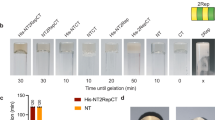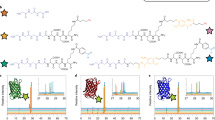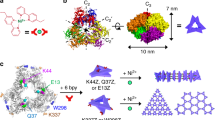Abstract
Metal-ligand interactions with various proteins form in vivo metal assemblies. In recent years, metallosupramolecular approaches have been utilized to forge an assortment of fascinating two- and three-dimensional nano-architectures and macroscopic materials, such as metal-ligand coordination polymeric materials, have promise in artificial systems. However to the best of our knowledge, the self-assembly of macroscopic materials through metal-ligand interactions has yet to be reported. Herein we demonstrate a gel assembly formed via metal-ligand interactions using polyacrylamide modified with Fe-porphyrin and L-histidine moieties. The stress values for the assembly increase as the concentration of Fe-porphyrin or L-histidine in the gels increases. Moreover, agitation of Fe-porphyrin gel, Zn-porphyrin gel and L-histidine gel in an 80 mM Tris-acetate buffer (pH 9.0) results in selective adhesion of the Fe-porphyrin gel to the L-histidine gel based on the affinities of Fe-porphyrin and Zn-porphyrin with L-histidine.
Similar content being viewed by others
Introduction
Metal-ligand interactions play an important role in naturally occurring systems. For example, hemoglobin can bind oxygen efficiently by formation of coordination bond between iron-porphyrin called a heme and L-histidine. Over the past decade, coordination-driven self-assembly has evolved into a well-established methodology for constructing novel metallosupramolecular structures using metal-ligand interactions. A variety of elaborate metallosupramolecules, from two-dimensional polygons to three-dimensional cages, prisms and polyhedra, have been reported based on coordination-driven self-assembly1,2,3,4,5,6,7,8. However to the best of our knowledge, the self-assembly of macroscopic materials through metal-ligand interactions has yet to be reported.
Previously we demonstrated macroscopic assemblies based on molecular recognition, which consisted of polyacrylamide gels modified with hosts and guest moieties9,10,11,12,13,14,15. Herein we demonstrate a gel assembly formed via metal-ligand interactions using polyacrylamide modified with iron-porphyrin (Fe-Por) and L-histidine (L-His) moieties. Moreover agitation of Fe-Por gel, zinc-porphyrin (Zn-Por) gel and L-His gel in an 80 mM Tris-acetate buffer (pH 9.0) results in selective adhesion of the Fe-Por gel to the L-His gel based on the affinities of Fe-Por and Zn-Por with L-His.
Results
Preparation of gels
Figure 1 shows the 2H-Por (x), Fe-Por (x) and Zn-Por (x) gel (x denotes the mol % of the 2H-Por, Fe-Por and Zn-Por moiety) and the L-His (y) gel (y denote the mol % of the L-His moiety) that we have designed. The metalloporphyrin gel was prepared by the reaction of metalloporphyrin with an N-hydroxy succinimidyl gel, which was prepared by terpolymerization of acrylamide (AAm), N,N′-methylenebisacrylamide (MBAAm) (cross-linker) and N-succinimidyl acrylate (Scheme S1). The L-His gel was prepared by radical terpolymerization of AAm, MBAAm and the L-His monomer under conventional conditions (Scheme S2). UV-Vis and 1H NMR spectroscopy were used to determine the mol % of 2H-, Fe-, Zn-Por and L-His in the gels (Fig. S1–S4).
The gels were cut into 5 mm × 5 mm × 1 mm pieces. The metalloporphyrin gel was used as prepared due to its easily identifiable color, but the L-His gel was stained red with a dye (food pigment red NO.102). Staining does not affect the association between the metalloporphyrin and the L-His moieties in the gels. Additionally, an acrylamide gel without the metalloporphyrin or L-His moieties was also prepared in a similar manner as a blank gel.
Assembly of the Fe-Por gel with the L-His gel
The Fe-Por gel and the L-His gel immediately adhere to each other upon agitation in an 80 mM Tris-acetate buffer (pH 9.0) (Fig. 2b, Supplementary Movie 1). The assembly formed from the Fe-Por gel with the L-His gel is strong enough to be picked up using tweezers (Fig. S5). In contrast, agitation of the 2H-Por gel and the L-His gel does not yield an assembly (Fig. S7b) and 2H-Por and L-His do not interact in a homogeneous solution (Fig. S9). Similarly, agitation of pieces of the same type of gel (e.g., Fe-Por gel pieces) or pieces of the blank gel with Fe-Por gel or L-His gel does not lead to assembly formation (Fig. S10, 11). However after metalation of iron to 2H-Por in the gel, the gel adhered to the L-His gel (Scheme S3, Fig. S7d, Supplementary Movie 2). The assembly of the Fe-Por gel with L-His gel showed a pH dependency. The L-His gel formed an assembly with the Fe-Por gel at pH 9.0, however, no assembly of gels was observed at pH 2.0 (Fig. S12a, 12b). The protonation of nitrogen atoms in the imidazole ring of L-His was suggested to inhibit the binding of L-His to Fe-Por (Fig. S13, S14, S15).
Pictures of the assembly, dissociation and reassembly of Fe-Por (1.3) gel (brown) with L-His (2.9) gel (red).
a) Fe-Por (1.3) gel and L-His (2.9) gel were placed in a petri dish and an 80 mM Tris-acetate buffer (pH 9.0) was added. b) Agitation for a few minutes led to a gel assembly. c) The addition of L-His solution and agitation led to the dissociation of the gels. d) These gels were washed using an excess of buffer and reassembled by agitation in fresh buffer. Solutions (i) 80 mM Tris-acetate buffer (pH 9.0); (ii) L-His solution added to 80 mM Tris-acetate buffer (pH 9.0).
Agitation in a buffer solution containing an 60 mM L-His solution causes the assembly of the Fe-Por gel and L-His gel to dissociate (Fig. 2c, Supplementary Movie 3), then washing with a fresh buffer solution reassembles the gel pieces (Fig. 2d, Supplementary Movie 4). The binding and dissociation of the Fe-Por gel with the L-His gel are reversible.
Macroscopic discrimination by the L-His gel between the Fe-Por gel and the Zn-Por gel
The ability of the L-His gel to form an assembly with the Fe-Por gel and Zn-Por gel was examined by simple agitation. When pieces of the Fe-Por gel, Zn-Por gel and L-His gel are agitated in an 80 mM Tris-acetate buffer (pH 9.0), the L-His gel only forms an assembly with the Fe-Por gel but not with the Zn-Por gel (Fig. 3, Supplementary Movie 5). A UV-Vis study on the interactions between metalloporphyrins and L-His in homogeneous solutions has shown that L-His prefers Fe-Por to Zn-Por because the association constant between L-His and Fe-Por is 5.2 × 103 M−1 (Fig. S16, S17) and that of L-His and Zn-Por is 1.4 × 102 M−1 (Fig. S18, S19)16,17,18. These results confirm that the difference of the association constant between L-His and Fe-Por or Zn-Por was reflected as the selective adhesion of the L-His gel to the Fe-Por gel.
Picture of macroscopic discrimination by L-His (2.9) gel (red) between Fe-Por (1.3) gel (brown) and Zn-Por (1.6) gel (red-brown).
Fe-Por (1.3) gel, Zn-Por (1.6) gel (red-brown) and L-His (2.9) gel (red) were placed in a petri dish. The addition of an 80 mM Tris-acetate buffer (pH 9.0) and agitation for a few minutes selectively formed an alternating self-assembly of Fe-Por (1.3) gel and L-His (2.9) gel.
Adhesion strength of the assembly of the gels
To investigate the adhesion strength of the assembled gels, the rupture stress was measured semi-quantitatively (Table 1). The stress values for an assembly of the Fe-Por (2.7) gel with the L-His gel increase as the concentration of L-His increases from 1.5 to 5.9 mol %. The Zn-Por (1.6) gel did not form an assembly with L-His (2.9) gel, however, Zn-Por gel formed an assembly with L-His gel by increasing the concentration of Zn-Por (1.6) gel and L-His (2.9) gel to 2.7 and 5.9 mol % respectively. These results suggested that the mechanical strength of the assembled gels is proportional to the mole content of Fe- and Zn-Por and L-His in the gels. Different affinities of metals to ligands give specific gel assemblies, demonstrating that metal-ligand interactions play an important role not only on the molecular level, but also on the macroscopic level.
Discussion
The Fe-Por gel formed an assembly with the L-His gel in an 80 mM Tris-acetate buffer (pH 9.0). In contrast, the 2H-Por gel and the L-His gel does not yield an assembly. However after metalation of Fe (III) to 2H-Por in the gel, the gel forms an assembly with the L-His gel. An assembly of the Fe-Por gel and the L-His gel was separated into each gel by agitation in a solution containing an 60 mM of L-His and the gels reassembled by washing with a fresh buffer. This result was suggested that the L-His moiety in the gel can recoordinate with Fe-Por instead of with L-His in a solution. These results indicate that metal-ligand interactions are responsible for self-assembly of the gels.
The Fe-Por gel, Zn-Por gel and L-His gel are agitated, the L-His gel only forms an assembly with the Fe-Por gel. The higher affinity of the L-His for the Fe-Por than that for the Zn-Por led to the selective binding of the Fe-Por gel and L-His gel.
Increasing the concentration of the L-His group in the L-His gel from 1.5 to 5.9 mol% increased the stress values for the assembly with Fe-Por gel. And Zn-Por gel formed an assembly with L-His gel by increasing the concentration of Zn-Por (1.6) gel and L-His (2.9) gel to 2.7 and 5.9 mol %, respectively. These results indicated that the number of metalloporphyrin and L-His group on the surface of the gels was important in the gel assembly. The surface coverage of the metalloporphyrin and L-His groups is expected to govern the adhesion strength of the assembled gel. The adhesion strength of the assembled gel can be regulated by changing the mole content of the metalloporphyrin or L-His group in the gels.
Metal-ligand interactions were utilized for the first time to assemble macroscopic gels. Simple agitation of Fe-Por and L-His gels resulted in selective adhesion. The stress values for an assembly of the metalloporphyrin gel with L-His gel increased as the concentrations of metalloporphyrin and L-His increase, indicating that the mechanical strength at the interface between the metalloporphyrin gel and the L-His gel can be regulated. Various hemes show their catalytic activities when a heme molecule is incorporated into an apoprotein with a Fe-Porphyrin-ligand coordination. We expect that the assembly of Fe-Porphyrin gel with L-His gel through metal-ligand interaction can macroscopically control the catalytic activity. The reversible self-assembly of porphyrin-gel with ligand gel may have a potential as activity controllable catalytic system.
Methods
The L-His gel was prepared by a radical terpolymerization of AAm, MBAAm and the L-His monomer19 using conventional conditions (Scheme S1). Immersion into a solution of a red dye (food pigment red NO.102) stained the L-His gel. Then the L-His gel was immersed in excess solvent. The metalloporphyrin gel was prepared by the reaction of 2H-20, Fe-20, or Zn-Por21 with an N-hydroxy succinimidyl gel, which was prepared by terpolymerization of AAm, MBAAm and N-succinimidyl acrylate (Scheme S2). Due to its color, the metalloporphyrin gel was used without staining. The mol % of metalloporphyrin, x, was determined by the Lambert-Beer law using the absorbance of a 30 μm thick metalloporphyrin gel. The UV-Vis spectra were obtained by a JASCO V-650 spectrophotometer (Fig. S1–S3). The mol % of L-His, y, was determined by a comparison of the integral values of protons in the main chain to that of the imidazole in L-His moiety in 1H NMR spectra (Fig. S4). The gels were cut into millimeter- to centimeter-sized pieces using a knife. Each gel was placed in a petri dish and 25 mL of an 80 mM Tris-acetate buffer (pH 9.0) was subsequently added. Then the mixture was agitated at 1000 rpm using Eyela cute mixer CM-1000 at room temperature. The stress-strain curves for the gel assemblies were recorded using a Yamaden RE-33005 Rheoner creep meter in the same manner as our previous report9,10,11,12,13,14,15. Each sample (5 × 10 × 2 mm3) was measured at a rate of 0.1 mm s−1 at room temperature. Iron metalation of 2H-Por gel was carried out by adding 2H-Por gel, FeCl3 and sodium acetate were added to glacial acetic acid, which suspension was refluxed (Scheme S3).
References
Rojo, J., Romero-Salguero, F., Uppadine, L. H. & Lehn, J.-M. Grid type metal ion architectures: functional metallosupramolecular arrays. Angew. Chem. Int. Ed. 43, 3644–3662 (2004).
Fujita, M., Tominaga, M., Hori, A. & Therrien, B. Coordination assemblies from a Pd(II) cornered square complex. Acc. Chem. Res. 38, 369–378 (2005)
Fiedler, D., Leung, D. H., Bergman, R. G. & Raymond, K. N. Selective molecular recognition, C-H bond activation and catalysis in nanoscale reaction vessels. Acc. Chem. Res. 38, 349–358 (2005)
Pitt, M. A. & Johnson, D. W. Main group supramolecular chemistry. Chem. Soc. Rev. 36, 1441–1453 (2007)
Zheng, Y.-R. et al. A facile approach toward multicomponent supramolecular structures: selective self-assembly via charge separation. J. Am. Chem. Soc. 132, 16873–16882 (2010).
De, S., Mahata, K. & Schmittel, M. Metal-coordination-driven dynamic heteroleptic architectures. Chem. Soc. Rev. 39, 1555–1575 (2010).
Granzhan, A., Schouwey, C., Riis-Johannessen, T., Scopelliti, R. & Severin, K. Connection of Metallamacrocycles via dynamic covalent chemistry: a versatile method for the synthesis of molecular cages. J. Am. Chem. Soc. 133, 7106–7115 (2011).
Argent, S. P. et al. High-nuclearity metal-organic nanospheres: a Cd66 ball. J. Am. Chem. Soc. 134, 55–58 (2012).
Harada, A., Kobayashi, R., Takashima, Y., Hashidzume, A. & Yamaguchi, H. Macroscopic self-assembly through molecular recognition. Nat. Chem. 3, 34–37 (2011).
Yamaguchi, H., Kobayashi, R., Takashima, Y., Hashidzume, A. & Harada, A. Self-assembly of gels through molecular recognition of cyclodextrins: Shape selectivity for linear and cyclic guest molecules. Macromolecules 44, 2395–2399 (2011).
Zheng, Y., Hashidzume, A., Takashima, Y., Yamaguchi, H. & Harada, A. Macroscopic observations of molecular recognition: Discrimination of the substituted position on the naphthyl group by polyacrylamide gel modified with β-cyclodextrin. Langmuir 27, 13790–13795 (2011).
Hashidzume, A. & Harada, A. Recognition of polymer side chains by cyclodextrins. Polym. Chem. 2, 2146–2154 (2011).
Yamaguchi, H., et al. Photoswitchable gel assembly based on molecular recognition. Nat. Commun. 3, 603 (2012).
Zheng, Y., Hashidzume, A., Takashima, Y., Yamaguchi, H. & Harada, A. Switching of macroscopic molecular recognition selectivity using a mixed solvent system. Nat. Commun. 3, 831 (2012).
Zheng, Y., Hashidzume, A., Takashima, Y., Yamaguchi, H. & Harada, A. Temperature-sensitive macroscopic assembly based on molecular recognition. ACS Macro Letters, 1, 1083–1085 (2012).
Foster, R. Organic Charge-Transfer Complex Academic Press.; New York(1969).
Robert, Q., Mario, N. & Joan, S. V. New five- and six-coordinate imidazole and imidazolate complexes of ferric tetraphenylporphyrin. J. Am. Chem. Soc. 104, 2588–2595 (1982).
Kenneth, L. B. A simplified method for spectrophotometric determination of equilibrium constants. Inorganica Chimica Acta 37, L513–L516 (1979).
Casolaro, M. Severino, B. Andrea, C. Mendichi, R. & Y. L-Proline functionalized polymers prepared by RAFT polymerization and their assemblies as supported organocatalysts. Biomacromolecules 5, 1325–1332 (2004).
Matsuo, T. Hayashi, T. & Y. Supramolecular hemoprotein linear assembly by successive interprotein heme-heme pocket interactions. J. Am. Chem. Soc. 129, 10326–10327 (2007).
Onoda, A. Kakikura, Y. Uematsu, T. Kuwabata, S. & T. Photocurrent Generation from Hierarchical Zinc-Substituted Hemoprotein Assemblies Immobilized on a Gold Electrode. Angew. Chem. Int. Ed. 51, 2628–2631 (2012).
Acknowledgements
We gratefully acknowledge the financial support from the Japan Science and Technology Agency (JST), the Core Research for Evolutional Science and Technoloty (CREST) program.
Author information
Authors and Affiliations
Contributions
A. Harada conceived and directed the project. Y.K. and H.Y. designed and performed the experiments. Y.K., H.Y. and A. Harada co-wrote the paper. A. Hashidzume and Y.T. contributed to the result disscussion.
Ethics declarations
Competing interests
The authors declare no competing financial interests.
Electronic supplementary material
Supplementary Information
The assembly of Fe-Por (1.3) gel (brown) with L-His (2.9) gel (red).
Supplementary Information
Iron metalated 2H-Por (1.4) gel formed an assembly with L-His (2.9) gel by iron metalation of 2H-Por in the gel.
Supplementary Information
The dissociation of an assembly of Fe-Por (1.3) gel (brown) with L-His (2.9) gel (red).
Supplementary Information
The reassembly of Fe-Por (1.3) gel (brown) with L-His (2.9) gel (red).
Supplementary Information
Macroscopic discrimination by L-His (2.9) gel (red) between Fe-Por (1.3) gel (brown) and Zn-Por (1.6) gel (red-brown).
Supplementary Information
supporting information
Rights and permissions
This work is licensed under a Creative Commons Attribution-NonCommercial-ShareALike 3.0 Unported License. To view a copy of this license, visit http://creativecommons.org/licenses/by-nc-sa/3.0/
About this article
Cite this article
Kobayashi, Y., Takashima, Y., Hashidzume, A. et al. Reversible self-assembly of gels through metal-ligand interactions. Sci Rep 3, 1243 (2013). https://doi.org/10.1038/srep01243
Received:
Accepted:
Published:
DOI: https://doi.org/10.1038/srep01243
This article is cited by
-
Precise synthesis of polyrotaxane and preparation of supramolecular materials based on its mobility
Polymer Journal (2021)
-
Macroscopic Supramolecular Assembly and Its Applications
Chinese Journal of Polymer Science (2018)
-
Manual control of catalytic reactions: Reactions by an apoenzyme gel and a cofactor gel
Scientific Reports (2015)
-
A metal–ion-responsive adhesive material via switching of molecular recognition properties
Nature Communications (2014)
Comments
By submitting a comment you agree to abide by our Terms and Community Guidelines. If you find something abusive or that does not comply with our terms or guidelines please flag it as inappropriate.






